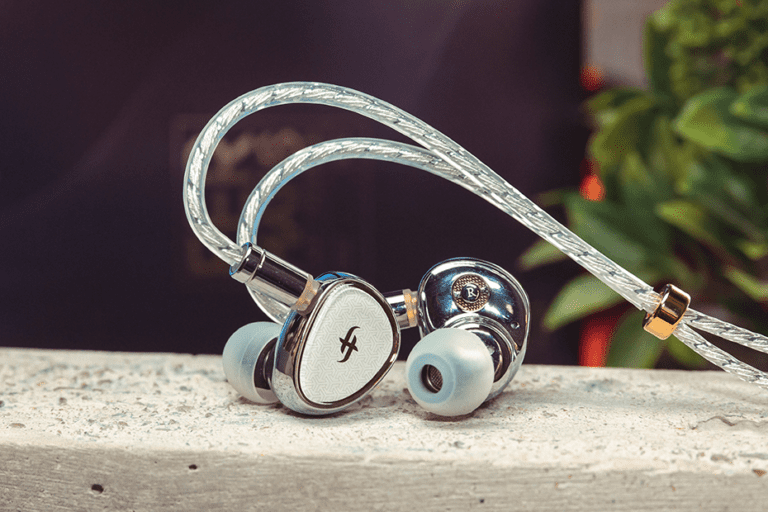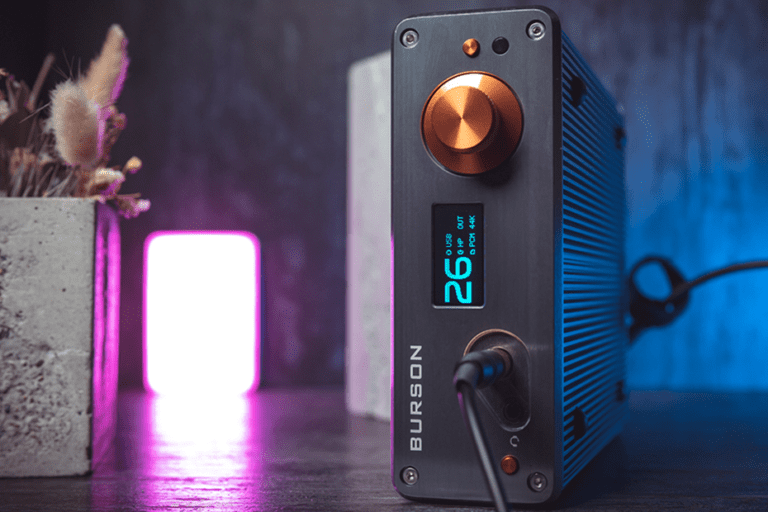
SIMGOT EA1000 Fermat review
Hello, I’m Alexander and today we are checking the Simgot EA1000 Fermat In-Ear Monitors. I want to thank SIMGOT for providing the sample for this review. No one paid me to make this review. I don’t offer any specific opinions. And all thoughts expressed in this review are my own.
Simgot EA1000 Fermat features 1 dynamic driver, 1 passive radiator and beautiful metal shells. It comes with 3 pairs of interchangeable nozzles, good quality de-attachable cable and a very interesting configuration. But as usual, we will start with the unboxing.
The IEM comes in a medium-sized glossy box. There is a model name and company logo on the front. The technical specifications, three frequency response graphs (one for each nozzle), and company information are on the sleeve’s back. Inside the sleeve, there is a black box.
In the box:
- SIMGOT EA1000 Fermat In-Ear Monitors
- De-attachable cable
- Two extra sets of tuning filters or nozzles
- 3 pairs of vocal silicone ear tips
- 3 pairs of balanced silicone ear tips
- IEM storage case
- Spare filter rings in 3 colors
- User manual
- and a warranty card
The unboxing experience was great and SIMGOT is one of those companies that pays attention to the packaging. The impedance of EA1000 is 16 Ohms, and the sensitivity is 127 dB.
🛒 SIMGOT EA1000 Fermat on Amazon
The IEM name is referring to Pierre de Fermat and his last theorem (thoroom). He was a French mathematician who is often called the founder of the modern theory of numbers. Fermat’s last theorem is a theorem first proposed by Fermat in the form of a note scribbled in the margin of his copy of the ancient Greek text Arithmetica by Diophantus. The scribbled note was discovered after his death, and the original is now considered lost. In the note, Fermat claimed to have discovered a proof that the Diophantine equation of the formula x^n+y^n=z^n has no integer solutions for n>2 and x,y,z!=0.
Design & build
Simgot made the shells of EA1000 out of metal and they consist of two parts. The face plate has glass-like surface with bezels and has a Simgot logo on it. The shells are medium on size with a short interchangeable nozzle. The nozzle diameter is almost 6 mm. The nozzles are also made from metal and there 3 pairs included with this IEM. There is a metal mesh at the end of each nozzle and a lip that helps to secure the ear tips. IEMs also have two vents, one on the inside part of the shell and another one near the nozzle.
There is also a passive radiator located on the inner part of the shell and there is a channel mark on the passive radiator as well.
The cable that comes with this IEM is fantastic. It’s 1.2 meters long 2-core Litz OFC silver-plated copper cable. There is a 3.5mm connector termination on one end of two 0.78 mm 2-pin connector termination on the other. The connectors are good quality and are gold-plated and the cable is low in microphonics. The cable also has a metal splitter and a metal chin slider, and a soft pre-molded ear guides. I don’t believe the cables affect the sound, but aesthetically this cable compliments the IEMs and feels quite durable.
Fit and comfort
While the design & build of EA1000 are really good, I can’t say the same about the fit in my case. I’ve tested dozens of IEMs in the last few years and finally came to a conclusion that in order to achieve a good fit & seal, the IEM should have long nozzles in my case.
This is not the situation with EA1000 due to shorter nozzle and the fit with stock ear tips was quite shallow. I was using this pair with DUNU S&S ear tips that helped me to achieve a better fit and seal.
If we put aside minor and subjective fitting issues, the EA1000 feels quite solid in the ear and if you are able to secure a good fit, it won’t be tiring during long listening sessions. But again, the IEMs might feel a bit heavy, especially if you are used to plastic shells.
SIMGOT EA1000 sound overview
As always, all sound impressions on my channel are completely subjective. You should take them with a grain of salt.
Simgot EA1000 Fermat has both low impedance and high sensitivity and as a result, you can drive it with ease with many portable sources. My Samsung Galaxy S10 is usually my first go-to device when I start the IEM evaluation and it had no problems providing enough power to make EA1000 shine. Pairing this IEM with better sources might provide marginal quality improvement, but this pair doesn’t scale much.
The IEMs come with three nozzles which slightly affect the tuning.
- The silver nozzle with red ring leans more to a Harman in-ear target curve
- The silver nozzle with black ring is the initial Simgot’s in-house tuning, which is a modified Harman’s in-ear target curve
- And the golden nozzle with white rings looks like an updated SIMGOT in-house tuning
I was performing all the tests with the silver nozzles with red rings, which in my opinion provided the most balanced tuning out of three. And now let’s discuss the frequency response of EA1000.
Bass, midrange, treble
The bass here is north of neutral, but not overly done. Bass extension is good and it goes quite deep. The mid-bass is more prominent here than the sub bass and it has a solid punch. Passive radiator is doing it’s job well and contributes to the bass tuning, providing additional rumble and body. The tracks that rely on mid-bass sound very dynamic. In addition the bass has a good control and sounds great with many genres of music, though there was occasional lack of bass on EDM tracks, so bass-heads take a note. The bass has a good texture, fast decay and there was no muddiness with busy musical tracks which is great. EA1000 is tuned to have a warm sound presentation that follows Harman in-ear target. But it still lacks a bit in the sub-bass department.
The midrange on EA1000 is very good and slight bass bleed makes it even better. The lower mids are quite linear and warm. The upper mids display an excellent character, and have never been intrusive in my case, even on high volumes. The lower mids are textured and detailed. They can sound thin on occasion, but slight EQ fixes it easily. The male vocals sound full, yet lack a bit of body, but guitars have just enough of bite for my personal preference. I don’t want to split hairs, as the texture and detail of the midrange s fantastic. Yet I think it could benefit a bit more from additional linearity and note weight.
Enjoying this review useful? Read more IEM reviews here
The treble is well extended, detailed and energetic. It has enough sparkle and air for my personal preference without sounding grainy or artificial. The treble reveals a lot of details and nuances and is a good example of a well-tuned treble. It also compliments to overall tuning well, and it’s great to see such a well-tuned single dynamic driver here. The treble is in my opinion somewhere in between analytical and smooth, so I think people from both camps will enjoy such tuning.
The technical capabilities of EA1000 are excellent, taking into consideration it’s configuration. The soundstage width is above average, and it’s also quite deep. Instruments hold their particular places in space well, and the soundstage feels large. The imaging is good. The detail retrieval is good too, and is on par with the class-leading models in this price bracket.
Overall the musical performance on EA1000 is very good and engaging. Besides, it also worked well for movies and games, as it rendered a realistic sound landscape with a good sense of distance and direction.
Simgot EA1000 vs EA500
During my tests I compared EA1000 with EA500 which I have also previously reviewed. The EA500 in my opinion is one of the best IEMs that you can get under $100 in 2024. It comes in all-metal design, has two interchangeable nozzles and is turned to closely follow Harman in-ear target too. And it’s also much cheaper than EA1000. So, is it worth upgrading to EA1000 from EA500 and spending almost three times as much? Yes, and no. So, let me explain.
First of all don’t let the graphs confuse you as EA1000 graph looks like EA500 with a better bass and treble extension. But what graphs can’t tell you, is how exactly these two pairs differ in sound.
The difference in my opinion is big. EA1000 sounds like a more refined and detailed version of EA500. It has a more detailed and textured bass. The bass control is better too. The midrange on EA1000 has more life, definition and texture too. The upper midrange is not as intrusive as it’ was on EA500. And the treble on EA1000 is more detailed and refined, and it doesn’t sound grainy as EA500 did on occasions.
I have also noticed that while there is no increase in soundstage width, the soundstage of EA1000 definitely feels more deep and that contributes to the overall perception of the sound stage. Technically speaking, the driver of EA1000 is way more capable. And with the added passive radiator, the whole configuration sounds much better and has a more mature tuning.
I consider the EA1000 to be the next logical upgrade from EA500, especially if you can get it on sale under $200. But at the same time to some listeners improvements in the build, sound signature, technical abilities and accessories would not be enough to justify the price difference.
So what do I like about this IEM?
It has a good build, has an excellent dynamic driver + passive radiator configuration, both from a technical perspective and it’s tuning. The IEMs have punchy textured bass with a good control, detailed midrange, excellent treble response, great technical abilities, very good cable and a wonderful set of accessories.
What I didn’t like?
The IEM case, while looking great, is not very durable. The shallow fit might be a deal breaker for some people (including myself), and the lower midrange could be more full and lush.
Conclusions
The EA1000 is almost perfect. Almost to the point, that I can forget about their shortcomings, including the fit (which is of course very subjective). This pair stands out with its full metal build, excellent driver technology and it’s capabilities, a bold idea to implement a passive radiator in the IEM, a warm-neutral sound signature with a detailed midrange and excellent treble. This makes it a perfect pair for those who seek a well-made IEMs that follow Harman in-ear target, and have a mix of neutral and fun sound signatures, spiced by a very good technical performance.
Overall, I consider EA1000 to be another successful release from Simgot. This pair is a next logical upgrade to EA500, though I would say they should’ve priced it a bit below $200 to compete with some other single dynamic driver IEMs, like Moondrop Kato and ThieAudio Elixir.
And that concludes my review for today. If you want to see more content like this consider subscribing to my YouTube channel for future updates. Thank you for joining me, and until next time, goodbye!
🛒 SIMGOT EA1000 Fermat on Amazon
** As an Amazon Associate I earn from qualifying purchases. Some of the links in my reviews are affiliate links. At no extra cost to you, I will make a small commission if you click and make a qualifying purchase.



